Written by Brian Kalman exclusively for SouthFront; Brian Kalman is a management professional in the marine transportation industry. He was an officer in the US Navy for eleven years.
While there was much fanfare and attention given to the July 3rd launch of two Type 055 guided missile destroyers at the Dalian Shipbuilding Industry Co. (DISC) shipyard in Dalian, very little mention has been made of the many other warships that the PLAN has launched or commissioned since the beginning of the year. Although the Type 055 DDG is the PLAN’s most powerful surface combatant, and the largest such vessel constructed by an Asian nation since World War II, they are one component in a steadily growing naval force structure. While the addition of three Type 055 DDGs this year, added to the first vessel in class which rolled into the water from Dalian just over a year ago in June of 2017, showcase China’s growing capabilities not only in producing powerful and modern warships, they also illustrate the maturity and stunning capacity of the Chinese ship building industry. This industry has launched and/or commissioned 15 modern warships in just the first seven months of 2018.
Three More Type 055 Destroyers
This year is proving to be a big year for the PLAN. Of the fifteen vessels built so far in 2018, three have been the newest and most powerful surface warfare vessel in the Chinese arsenal, the Type 055 DDG. The world was stunned when China was able to complete the first of this new class in June of 2017. Sections of a second in this class were clearly visible in satellite imagery at the time. That vessel was launched in May of this year, but two more Type 055 destroyers were launched simultaneously on July 3rd, just two months later. The 5th and 6th vessels in class are already in varying stages of construction.
Although initial reports had suggested that a total of six vessels had been ordered, it has been hinted that this number has been increased to eight. This number will most likely grow to at least 12 vessels by 2025, when the PLAN will be looking to expand its aircraft carrier program with the introduction of at least one carrier of the Type 002 class. It has yet to be determined if this new carrier (CV-18) will employ steam or electromagnetic catapults, but it will definitely be a CATOBAR carrier. PLAN aviators continue to practice CATOBAR take-off and landings at the Huangdicun Airbase in southern China. Chinese naval engineers have had a great deal of success in developing an Electromagnetic Aircraft Launching System (EMALS) that requires much less energy than the system currently utilized aboard the U.S. Navy’s Gerald Ford Class carrier. It remains to be decided if the Type 002 will be conventionally powered, or will make use of a nuclear reactor.
Regardless of the next generation carrier’s specific design specifications and capabilities, powerful surface warfare ships will be required to escort them in a larger aircraft carrier battle group formation. The Type 055 DDG will likely serve a similar role as the Ticonderoga Class CG of the U.S. Navy within the carrier strike groups (CSG), and will also be utilized as a command ship or heavy AAW and ASW platform in PLAN naval task forces or while supporting amphibious ready groups (ARG). The Type 055’s significant weapons payload, multifaceted offensive and defensive capabilities, and great range and endurance will aid Chinese efforts to protect and expand its maritime territories, protect its shipping lanes, and maintain its naval lines of communication.
Type 052D DDG Continued Growth
A number of photos that appeared both online and in the print media exhibiting the two newest Type 055 DDGs to be launched at the DISC shipyard in Dalian failed to mention that three brand new Type 052D destroyers also appeared in these same images. The Type 052D is a powerful guided missile destroyer in its own right, rivaling the U.S. Navy Arleigh Burke Class DDG. China launched the first Type 052D, the Kunming DDG-172 in 2014. There are currently 9 ships of the class in service, 2 undergoing sea trials, and a further two being fitted out. Three Type 052D DDGs have been commissioned in the first half of this year.
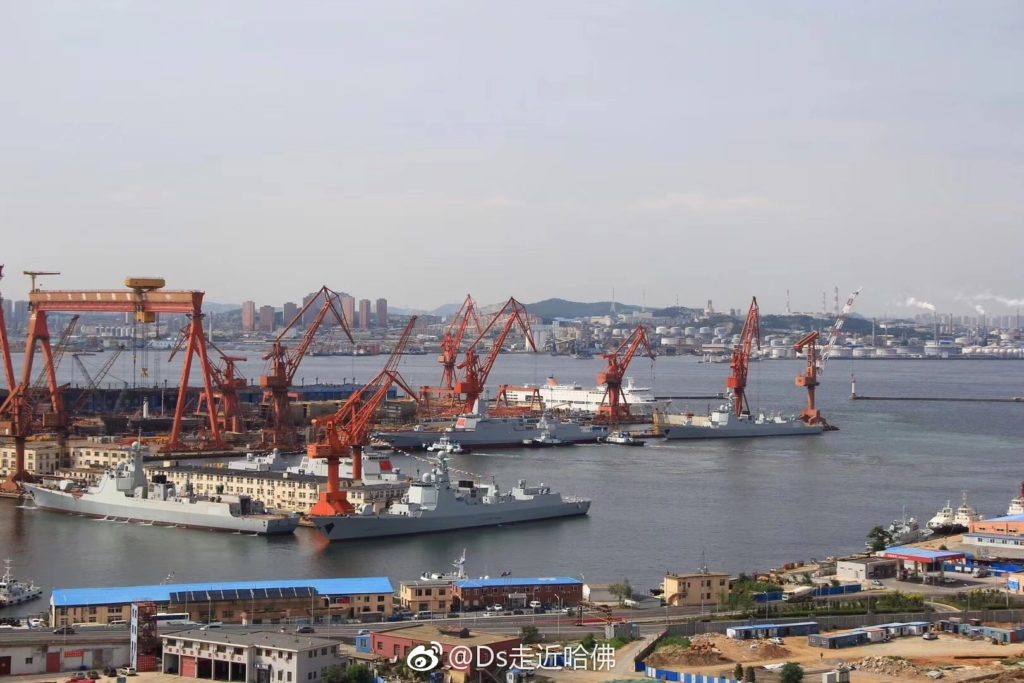
No less than five destroyers in various stages of fitting out are docked at the Dalian Shipbuilding Industry Co. (DISC) shipyard on July 3rd; three Type 052D and two Type 055 DDGs.
Although original rumors had hinted at 16 vessels being ordered, some inside sources now claim that the number has been increased significantly. It would seem reasonable that a total of 18 to 26 vessels may end up being built, dependent upon how ambitious the PLAN aircraft carrier program becomes. IHS Janes Defense Weekly reported on May 2nd of this year that satellite imagery appeared to show a Type 052D under construction at the Jiangnan Changxingdao shipyard in Shanghai that had approximately 4 meters (13.1ft) added to its LOA. The after flight deck may have been lengthened to accommodate larger helicopters which would aid the vessel in its ASW role.
It remains to be seen if the above mentioned modification will enter serial production under a different designation, or will prove to be a concept testbed for fielding larger rotary wing assets at sea. It is important to note that China produced six Type052C Class DDGs from 2004 to 2015, and has produced thirteen of the much improved Type 052D Class DDGs in just four years, a six fold increase in annual production.
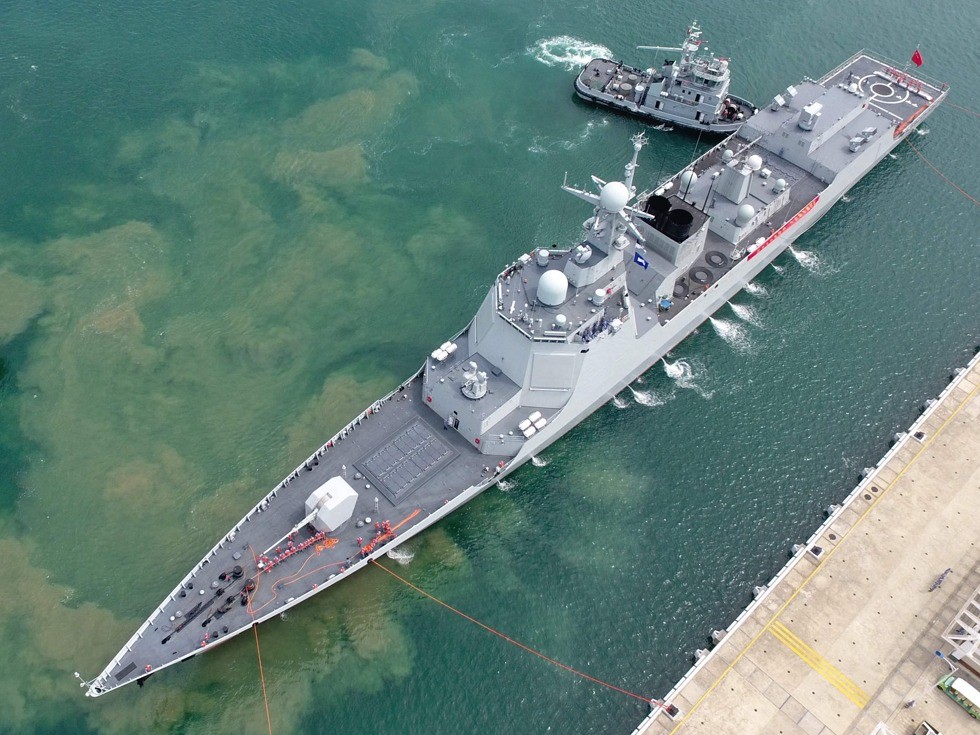
A Type 055D DDG docking with the aid of a tug at a PLAN naval base. The deck gun and forward 32 cell VLS are clearly visible. Although bearing some similarity to the U.S. Navy’s Arleigh Burke Class DDG, the Type 052D is more streamlined and esthetically pleasing. Its good looks likely equate to a much smaller radar signature.
More Frigates and Corvettes
While smaller warships do not enjoy the limelight of their larger peers, they can teach the observer a great deal about a nation’s maritime defense posture and priorities. While the Chinese shipbuilding industry has constructed and launched nineteen Type 052 DDGs of both variants, and four Type 055 DDGs from 2014 to the present, they have also turned out fourteen Type 054A Class guided missile frigates (total of 32 of all variants) and a no less than twenty Type 056A Class corvettes (total of 42 in class of all variants) over the same period of time.
The smaller warships traditionally perform a number of different roles in naval warfare. Firstly, they serve as coastal patrol craft. They are nimble and fast, heavily armed for their diminutive size, and are outfitted to be flexible enough to perform a multitude of different missions. Their small size equates to limited firepower and shorter range, but they are well suited to serve as picket ships and screening forces to task forces fielding larger and more powerful vessels when those fleets are operating within close range of home ports and naval facilities.
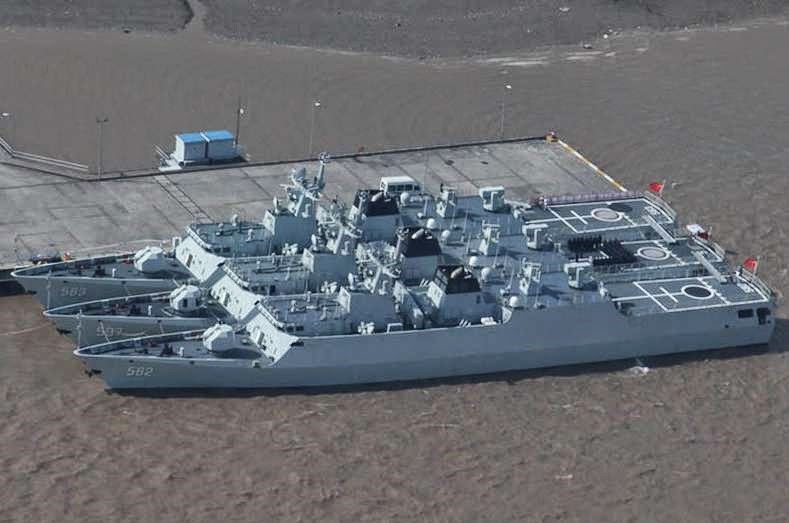
Three Type 056A Class corvettes tied-up alongside one another. The vessel in the middle is conducting a crew muster on the aft flight deck. Approximately half of the 42 vessels in the Type 056 class are of the upgraded Type 056A variant.
The Type 056A Class corvette is ideally suited to patrol China’s coasts, the maritime territories within China’s EEZ, as well as the island archipelagos of the Paracel and Spratly Islands. They will most likely begin patrol operations from the key island bases at Fiery Cross Reef, Subi Reef, and Mischief Reef as the maritime logistics facilities on these islands are improved.
The Type 054A frigate is a well balance and powerful naval surface combatant for its size, and carries an ample arsenal of anti-aircraft, anti-ship, and anti-submarine weapons. It is an ideal escort vessel with a range of over 8,000 nautical miles. It is a traditional multi-purpose frigate, possessing the inherent ability to attack other surface ships, engage aircraft, and track and destroy submarines. It is this class of warship that the PLAN first sent to the Gulf of Aden in 2009 to serve in international anti-piracy duties. Eleven Type 05A frigates have served on anti-piracy duties in this region since that time.
The Type 054A Class Frigate is a flexible, yet powerful surface warfare asset that possesses significant range and the ability to engage in a multitude of operations. It is equipped with an aft hangar and flight deck, and carries either a Ka-28 or Harbin Z-9 helicopter depending on mission requirements. Type 054A FFGs will likely be deployed as part of naval flotillas stationed on a rotational basis at the PLAN naval base in Djibouti, and eventually at Gwadar, Pakistan. They will also be used to police the long maritime supply lines to and from China to strategic waterways near the Horn of Africa and the Straits of Hormuz, as well as continuing patrols in the South China and East China Seas.

Type 054A Yiyang, FFG-548. This vessel was constructed in 2010 and was the seventh vessel in class to be built. Note the 32 cell VLS forward of the superstructure, 76mm dual-purpose deck gun, and Type 87 anti-submarine rocket (ASROC) launchers just forward of the deck gun. Amidships are the twin 4 cell launchers for the C-803 anti-ship/land attack cruise missiles.
New Nuclear Submarines
Without a doubt one of the segments of Chinese defense strategy most shrouded in mystery are the attack submarines and ballistic missile submarines of the PLAN. They are very rarely a topic of discussion by government officials, either on or off the record. What is known is that the PLAN has a newer SSN and SSBN in service. China’s submarine technology has run behind that of both the United States and Russia for decades, but China has been rapidly closing the gap in recent years. It is no secret that Chinese espionage efforts to acquire U.S. submarine warfare technology have been very active, and quite successful over the past decade in particular.
The most capable nuclear attack submarine (SSN) in service with the PLAN is the Type 093B. A notable improvement over the Type 093, it has the capability to fire submarine launched cruise missiles (SLCM) while submerged via a dorsal mounted VLS. Like its predecessor, the Type 093, it retains the ability to fire SLCMs from its bow torpedo tubes. This is accomplished by using a specifically designed torpedo tube missile canister. It is not known how many Type 093B SSNs are currently in service, but most analysts, including those at the U.S. Office of Naval Intelligence, put the number at six. Of greater interest is the newer SSN that is either currently being fitted out or is undergoing sea trials later this year, the Type 095.
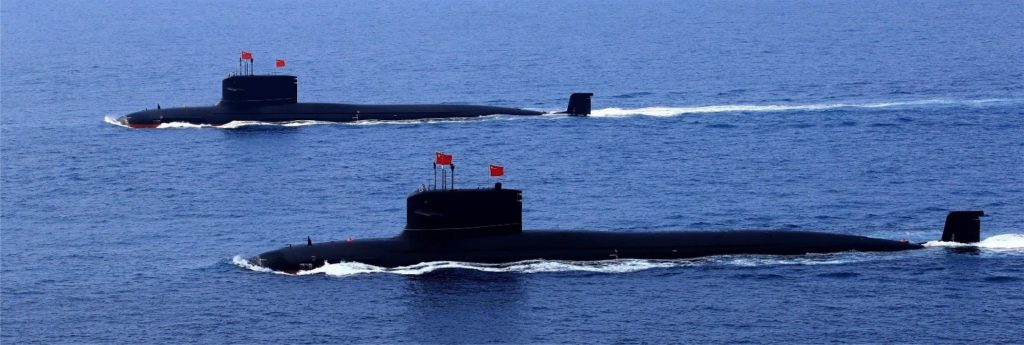
A pair of Type 093B SSNs. Of particular interest in this image are the improved hydrodynamics of the conning tower and the slight dorsal hump denoting the presence of a VLS for launching anti-ship and land attack cruise missiles.
The Type 095 is an SSN, but reportedly has a sizeable VLS (12-16 cells) which can fire a multitude of PLAN missiles including anti-ship cruise missiles (ASCM) and land attack cruise missiles (LACM). The U.S. Office of Naval Intelligence has classified the Type 095 as a nuclear attack guided missile submarine (SSGN) due to its large missile capacity. The Type 095 is thought to utilize pump-jet propulsion, make use of noise reducing technologies, and a hybrid pressure hull design.
The Type 095 is being constructed at the new Bohai Shipbuilding Heavy Industry Company (BSHIC) submarine manufacturing facility located in Huludao, in the Liaoning province. It is the largest submarine manufacturing facility in the world, with an assembly building measuring some 430,000 square feet (39,948 sq. meters). Completed in 2017, the main assembly hall can accommodate four submarines at any given time. The facility is totally enclosed, and operations cannot be viewed from the air or via satellite surveillance. This also allows manufacturing operations to continue year round regardless of weather conditions. The facility will be used to build all Type 095 SSN and Type 096 SSBN class submarines.

A satellite image of the BSHIC submarine manufacturing facility in Huludao in the province of Liaoning, China.
The Type 094 Jin Class nuclear ballistic missile submarine has also undergone a noticeable transformation, resulting in what has been renamed the Type 094A. Improvements to the new variant include a larger VLS aft of the conning tower, a more streamlined shape which produces less noise and cavitation while submerged, likely greater speed submerged (less hydrodynamic drag), and a new ballistic missile armament. The Type 094A is most likely equipped with the next generation JL-2A submarine launched ballistic missile (SLBM). The JL-2A is based on the DF-31, and has an estimated maximum range of 11,200 kilometers (6,960 miles). The JL-2A is likely equipped with a multiple independently targetable reentry vehicle (MIRV) warhead. The PLAN likely has between four and six Type 094/094A class SSBNs in service. These SSBNs serve as the third leg of the nuclear deterrent triad that China lacked for so many years, and the 094A offers China a viable second strike capability. The Type 096 SSBN currently being designed will offer notable improvements over the 094A SSBN, yet little is known about the project.
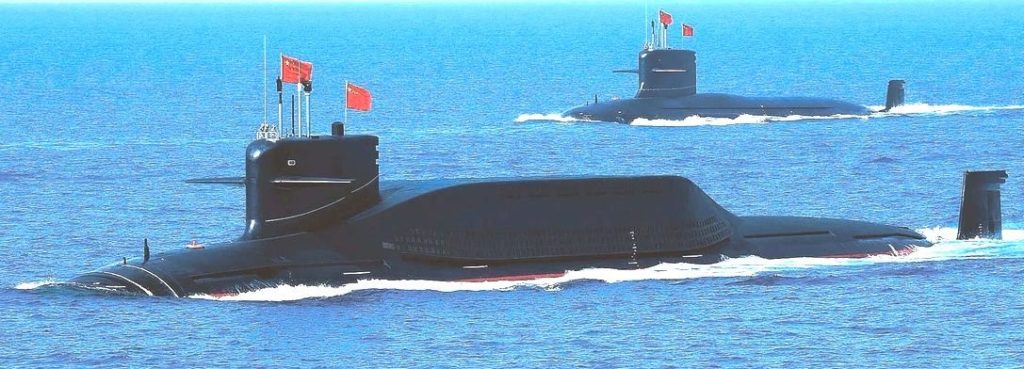
This rare image shows not only a Type 094A Class SSBN in the foreground, but also a Type 093B Class SSN in the background. The improved hydrodynamics of both vessels can be seen, especially in the conning towers that now lack windows. The large dorsal hump of the Type 094A houses the powerful JL-2A submarine launched ballistic missiles that have a range in excess of 11,200 kilometers.
The Sixth and Final Type 071 LPD?
The final Type 071 Class LPD of the original order of six vessels was launched at the Hudong-Zhonghua shipyard on January 20th of this year. The fifth vessel was launched just 7 months prior. It remains unknown if the PLAN will decide to order additional LPDs of this class, or will concentrate instead on the larger Type 075 LHDs currently under construction at the same shipyard which constructed all six Type 071 LPDs.
It is logical to conclude that China may decide to build additional Type 071 LPDs, but this will depend perhaps on how long it takes to construct, launch and commission the first of the new class of LHDs. With six LPDs in service, after the final two vessels are finally commissioned, the PLAN will always have at least two of them ready to deploy as the backbone of a small Amphibious Ready Group (ARG). A PLAN ARG would likely consist of at least one Type 071 LPD, 2 Type 072 LSTs and a surface warfare escort of a mix of DDGs and FFGs.
These smaller amphibious warfare vessels lack the size and capability of bringing their own aviation strike element with them. The Type 071 can accommodate two helicopters on its large aft flight deck, and is equipped to house four helicopters in the adjacent hangar. The Type 072 LST can also accommodate one helicopter on its after flight deck. Lacking a VSTOL attack aircraft, the PLAN will most likely modify the Z-10 attack helicopter for naval use, with it serving a similar purpose as the U.S. Marine Corps AH-1Z Viper and Russian Ka-52k naval attack helicopters. China has already conducted take-off and landing tests with Z-10s on both the Type 071 LPD and 072A LST. The Type 075 LHD will undoubtedly have an attack element of at least eight to ten modified Z-10s.
It is clear that a larger amphibious warfare platform is a requirement for the PLAN in the immediate future. If the time it took China to design, build, launch and fit-out its first indigenous aircraft carrier is an indicator, we are likely looking at the first Type 075 to be launched sometime in 2020. Fitting out and sea trails will take an additional two years before the first vessel is commissioned. The LHD is without a doubt the most flexible and capable of all amphibious warfare platforms and the PLAN will need these vessels to be able to field viable ARGs to respond to challenges within its maritime territories and to project power at greater ranges along the full length and breadth of the Maritime Silk Road.
The All Important Support Vessels
China signaled to the world that it fully intended to field aircraft carrier battle groups (CBG) in the near future when it launched the first Type 901 Fast Combat Support Ship in December of 2015. Built by Guangzhou Shipyard International Company Ltd. (GSI), the first vessel in this class Hulun Hu (hull # 965), commissioned in September of 2017 after successful sea trials and UNREP trails, bears the distinction of being the only fast combat support ship fielded by a nation other than the United States, which operates the Sacramento and Supply Class vessels. These massive underway replenishment ships are designed to be able to meet the logistics needs of fast moving carrier battle/strike groups.
The Type 901 is a massive vessel, with a fully loaded displacement of 48,000 tons. It is equipped with five liquid bulk cargo transfer stations, three on the port side and two on the starboard side, and is also equipped for liquid transfers astern. They can refuel an aircraft carrier with fuel oil and aviation fuel to starboard while supplying fuel oil to surface warfare escorts to port. The disclosed cruising speed is in excess of 25 knots, which is likely understated. It is equipped with a large aircraft hangar and flight deck that can accommodate large Z-8 heavy transport helicopters which are well suited to aerial replenishment duties. A second Type 901 is currently in an advanced state of construction.
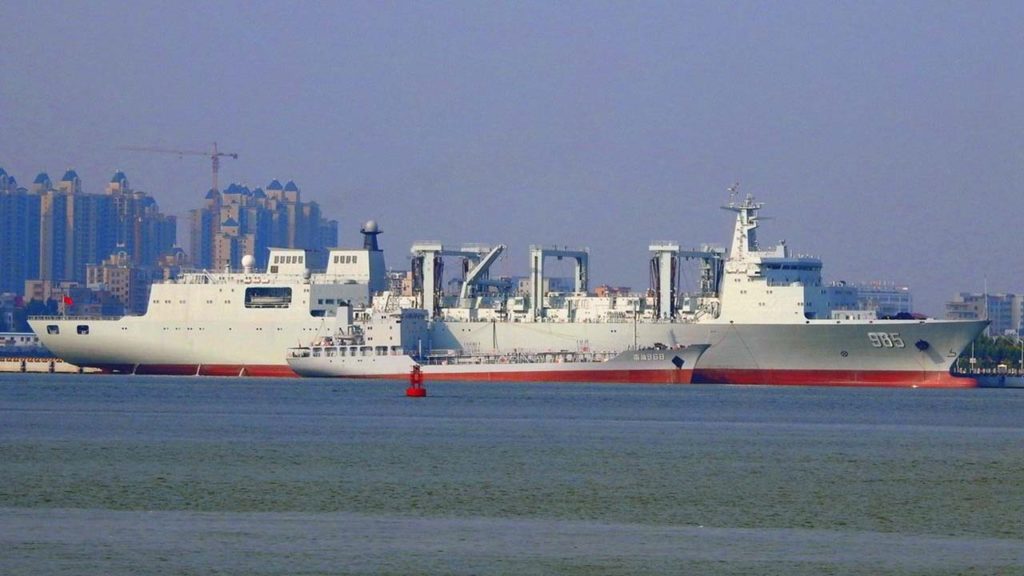
The massive size of the Type 901 is clearly on display in this image. The vessel tied up alongside Hulun Hu is a Type 640 Class auxiliary tanker.
The PLAN also operates the Type 903 and Type 903A Class fleet replenishment vessels. The Type 903 was greatly improved and took on the designation Type 903A with the first two examples commissioned in the summer of 2013. There are six Type 903A replenishment ships on active service, and a seventh currently in an advanced state of construction. These vessels have a fully loaded displacement of approximately 24,000 tons and can carry 10,500 tons of bunkers (fuel), 250 tons of potable water, and roughly 700 tons of dry cargo.

Type 903A Honghu, commissioned in July of 2016. The PLAN should take delivery of the seventh such vessel sometime in the middle of 2019. The PLAN increased production of this class of vessel since the first was commissioned in 2013. Four were commissioned in a span of just 8 months from December 2015 to July 2016.
Fleet replenishment vessels are a vital component of a blue water navy. They allow fleet task forces, carrier battle groups and amphibious ready groups to engage in complex missions thousands of miles from home ports and over extended periods of duration. They replenish fuel, food stores, fresh water and munitions to warships while underway, and can provide a rapid logistics solution to both naval and land forces deployed to far flung bases and garrisons. These vessels are indispensable to aircraft carrier battle groups engaged in long deployments.
The Big Picture, PLAN 2025
The rapid pace of warship construction by China is impressive from an engineering and manufacturing standpoint, but of greater interest is in understanding the motivation behind such an ambitious program. Why has the Chinese leadership decided that the PLAN must expand and acquire a full spectrum of naval warfare capabilities that it has previously lacked, and in such a short space of time? The answer to this question becomes clear after a short analysis of China’s geopolitical, economic and national security goals in the twenty-first century.
In many ways, China is engaged in a concerted effort to redefine the economic realities that have established the way the world exchanges goods and services, and distributes the product of human endeavors globally. The New Silk Road/Maritime Silk Road project seeks to once again make China the center of the economic world. China is already the largest economy in the world in terms of economic production, and is on pace to usurp the U.S. as the world’s largest economic consumer as well. Continued growth and prosperity depend upon cheap and efficient movement of energy resources and raw materials to China, and the cheap and efficient movement of finished goods from China. The overwhelming majority of these influxes and outflows transit the international waterways of the world. Continued prosperity and stability depend upon the security of these maritime lanes of trade. In strategic terms, these naval lines of communication must remain open. In times of strife and natural or man-made disaster, China must have the capacity to secure these lines of communication and to keep them open. The great naval strategist Rear Admiral Alfred Thayer Mahan, writing in 1893, then just a Captain, stated this concept very succinctly:
“Let us start from the fundamental truth, warranted by history, that the control of the seas, and especially along the great lines drawn by national interest or national commerce, is the chief among the merely material elements in the power and prosperity of nations. It is so because the sea is the world’s great medium of circulation. From this necessarily follows the principal that, as subsidiary to such control, it is imperative to take possession, when it can be done righteously, of such maritime positions as contribute to secure command.”
Although China has been the first and most determined nation to move in this direction, it is not alone. As China moves to build a new logistics system that aims to redirect the movement of information, energy, and economic goods that competes with the current established system dominated by the United States, the United States and its allies are determined to maintain the status quo. Some of these allies, such as India, are allies of necessity and are also attempting to maintain their independence. China has accepted the wisdom of long standing naval strategy, and has proven the most decisive in embracing these centuries old concepts.
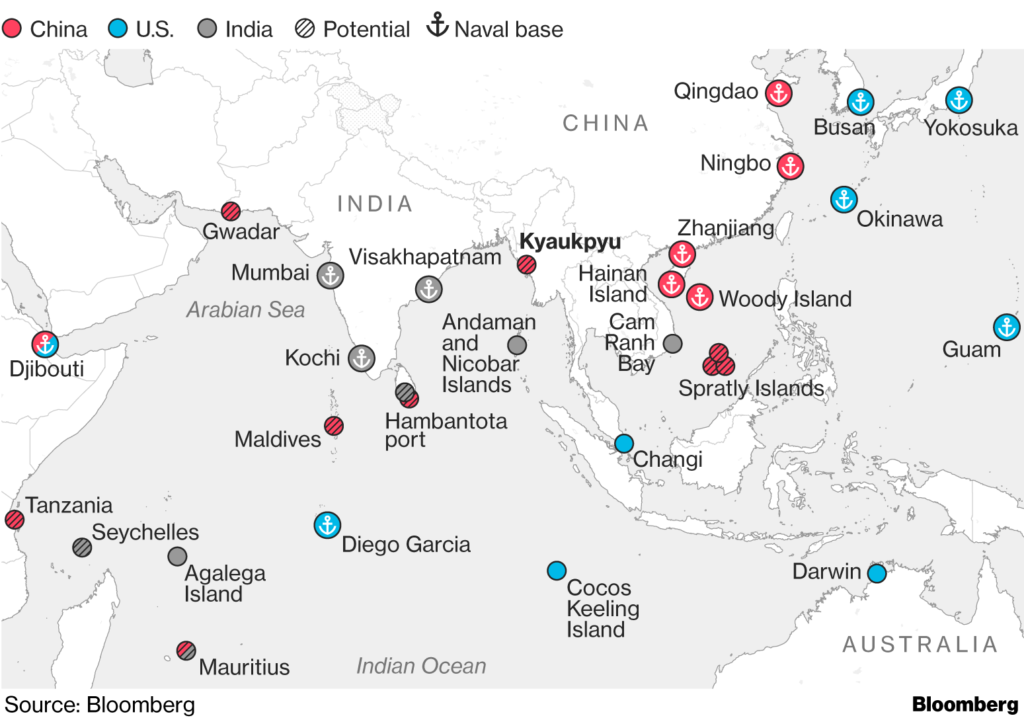
This map illustrates established and potential naval bases of rivals in the Indian Ocean, South China Sea and Asia Pacific regions. The U.S. bases were established through imperialist expansion, war and the long running U.S.-U.K. alliance. India has moved to leverage its own cooperative relationship with the U.S.-U.K. alliance and also maintain a level of independence. China has moved to secure the maritime lines of communication to and from Africa and the Middle East. Bases in Gwadar and Kyaukpyu will prove indispensable if either the Straits of Malacca or Aden become impassable.
If China does not alter its current building projects by increasing or reducing orders, the PLAN will still be a highly transformed fighting force by 2025. The year 2025 will prove to be a milestone for the PLAN for many reasons. By 2025, China will likely be declaring its first Type 002 Class aircraft carrier operational. The Type 002 will be an EMALs assisted CATOBAR capable carrier that may likely be nuclear powered. At the same time, two other aircraft carriers, although recognized as developmental steps along the way to the Type 002, will also be in service. Based on the pace of pilot training and the procurement of aircraft over the past decade, the PLAN will have at least one more regiment of carrier strike aircraft in service, bringing the total to two regiments. China is already seeking to develop and field a carrier borne strike aircraft superior to the J-15, even though many of the J-15’s shortcoming will be rectified by the improved CATOBAR system of the new Type 002 carrier.

Liaoning CV-16 with its air wing of J-15s and rotary wing ASW and support aircraft, and a Type 054A frigate escort. A modest yet impressive start in carrier borne naval aviation, and definitely just the beginning.
The Plan will have 30 Type 054A Frigates, 18 Type 052D and 8 or more Type 055 Destroyers in service. Improvements upon the destroyers will likely occur in the intervening years. A total of 50 Type 056 Corvettes (28 of the Type 056A improved variant) will be policing the coastal waterways of China and its outlying island territories. These modern and capable surface warfare vessels will be supplemented by older vessels that China has been actively modernizing.
The PLAN will be able to transport an enlarged PLA Marine Corps to battle in its first Amphibious Ready Group, albeit with limited capabilities. The First Type 075 LHD will be undergoing operational training to test the capabilities of the vessel and familiarize sailors, marines and airmen with amphibious and air assault missions from such a complex and powerful platform. There will be six Type 071 LPDs in service, as well as 15 Type 072A LSTs. The majority of an additional 17 Type 072 LSTs of an earlier, yet sound design will still be in service. The recently expanded PLAMC, numbering approximately 100,000 men, a five-fold increase from 2017, will finally have the modern amphibious sealift capacity that it currently lacks. PLAMC marines will serve in duties deployed at sea and stationed at a growing number of Chinese sovereign island bases, or abroad at naval bases in foreign countries such as Pakistan and Djibouti.
By 2025, the PLAN will have a robust naval logistics arm available to support naval operations across the length and breadth of the Maritime Silk Road. Two Type 901 fast combat supports ships, and 9 Type 903A replenishment ships will be available at a minimum. Four Type 904 general stores issue vessels are currently in service to resupply island garrisons and offshore bases. This number may be increased in the intervening years.
Of equal interest is the question of just how the U.S. Navy will look in 2015. It will still be the largest and most powerful navy in terms of global reach and power projection; however, it is a military branch that seems to be without focus or direction. The PLAN has increasingly invested in high tech, powerful and flexible conventional warships that are also cost effective when compared to the new designs pursued by the U.S. Navy. Even the Type 002 aircraft carrier is a conservative design, with a limited mission foreseen for it, one which will minimize its weaknesses and make use of its strengths. It is telling that China has built the largest surface warfare ship since the U.S. commissioned the last Ticonderoga Class cruiser Port Royal CG-73 in 1994. The U.S. has no plans to replace the 22 Ticonderoga Class cruisers anytime soon, nor is there a replacement design to consider. The Gerald R. Ford Class CVN-78 has proven to be a costly and disappointing investment so far. It will use the F-35 JSF and F-18 Super Hornet which lack the range to be a threat to peer adversaries. The Zumwalt Class DDG is a dead end failure and the troubled LCS program has proven to be less capable than the traditional multi-purpose frigate designs of other major navies.
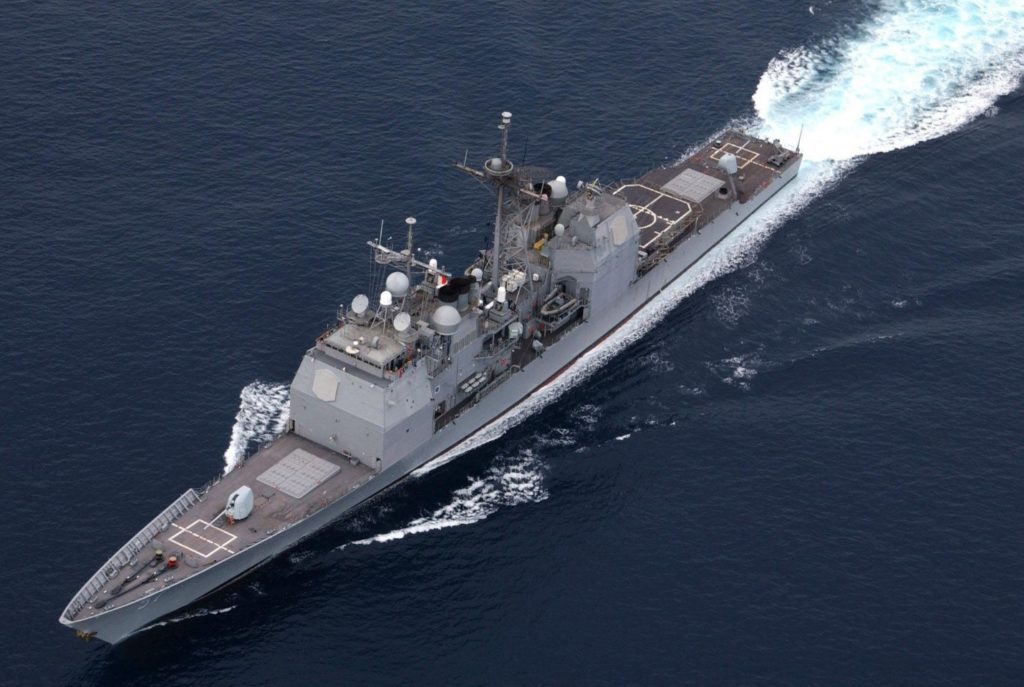
Ticonderoga Class cruiser USS Lake Champlain CG-57. Decommissioning of these vessels will begin in 2019, with no viable replacement. The U.S. Navy command has proposed keeping half of the 22 vessels in service. Despite the largest defense budget of any nation in the world, and larger than that of Russia and China combined, the U.S. Navy cited budget constraints as a key factor in being unable of replacing the vessels.
While the U.S. has wasted its great wealth on failed designs, whose sole aim is to earn profits for a defense industry more interested in profit-generating waste than in producing weapons systems that balance capability, efficiency and cost effectiveness, China has done something quite different. China has produced cutting edge warships and aircraft for its navy that are largely improvements upon proven designs and technology. China has made major progress in missile technology, surpassing the U.S. in many respects. It has also reaped rewards from years of investment in research and development of advanced radar and even photon detection technologies. There is no doubt that China has gotten far more return on its investments in terms of its defense industry in comparison to the United States. For the military defense complex that rules the United States the goal is profit, not the defense and security of the nation.
From 2001 to the present, the United States military has morphed into a force obsessed with counterinsurgency and occupation, leaving it woefully unprepared for a conventional conflict with peer adversaries, such as Russia or China. The U.S. Navy has transformed into a global police force meant to be used as a stick to bludgeon any small nation that dares to disobey the diktats of Washington. Its powerful aircraft carrier strike groups (CSG) lack the air wing capable of striking the shores of powerful adversaries, rendering these great symbols of U.S. power impotent against any capable foe in a major conflict. The U.S. Navy is powerless to change the strategic situation in the South China Sea through military means, as China has already “crossed the Rubicon”. Imperial hubris, corruption and arrogance have done greater damage to the U.S. military than any foreign adversary has over the past 17 years.
The year 2025 will witness a PLAN in ascent and a U.S. Navy in decline. This is not to say that the U.S. Navy will not still be the preeminent naval power globally, but it will continue to be mired in a lack of strategic direction, focus and budgetary crisis. The PLAN will be guided by a clear strategic focus, increasing capabilities, and a robust shipbuilding and weapons acquisition program. There is no doubt that the PLAN will emerge as the second most powerful navy in the world, and will exert significant influence in both military and geostrategic terms.






I’m sure Djibouti considers it good business to lease bases to US and China at the same time. They may regret that decision in the case of a shooting war.
Aden has been a Western Naval base for centuries, dating back to Portuguese and British Empires. China also tried to gain influence there in the 1400s. Now it can be Russia’s turn! :D
China is already set up at Gwadar Pakistan with FUKUS at Djibouti and Diego Garcia the region should be a new theater of WW3 any day now.
Impressive article I should show my retired low officer level from 17year old enlistee USNavy father, but his automatic scoffing at any ‘alternative’ news source makes that highly unlikely.
Spelling typo: ascent, not accent
Thank you. Updated.
too many people in US under propaganda spell that chinese and russian military gear are totally junk compared to western made weapons..
normalcy bias , this will really destroy the western military in the next war , because even the military and the leaders of western world believe in their own propaganda.
Western arrogance will be their downfall… if they really go against countries like Russia or China..
And so far, my nation, the US of A, has acted with the highest level of what can only be described as pure evil. But human competitive psychology shows that ‘winners’ testosterone/stupidity levels generally rise just by ‘winning’ while losers’ levels tend to fall. (This is the same for women, just at much lower hormone levels.)
That explains why World Empires throughout history have become the most evil.
For the future of our species, assuming the unlikely scenario that we even have one, I fear whichever empire follows us will only become even worse than ours! How do we change this destructive natural psychology? Is there any hope for egalitarian peace?
Sure. Techniques to balance our internal body, in terms of hormones, electrical energy, etc. have been known for millennia. Second, subject people aspiring to high political office to stringent psychological, similar to what is done for many special operations soldiers, to weed out the kind of self-aggrandizing sociopaths atht plague the current US system.
If only it were so easy! That system depends that society maintain complete control over the leader personalities it is selecting, while the nature of those personalities is to control it all. Our hero-worshipping psychology makes it too easy to hand them the controls and charismatic leader personalities are too good at lying!
Ah, well, that’s life in general. The solutions are usually simple. Implementing them is the tricky part.
Similarly with China’s new AS missiles, having at least 3x the range of the outdated U.S. harpoons means all U.S. navy surface ships are now sitting ducks for the YJ12 and YJ18, while its carriers will be good target practice for the DF-26. The only viable assets of the USN are its nuclear subs, a Samson option of the last resort.
Important observation in this discussion.
China needs to expand their nuclear capabilities.
How do you know they haven’t?
America, America…you opened Pandora’s box, now live with it, you retards.
Chinese ship building prowess directed by a sound strategic approach, will provide China with a considerable blue water naval force, along with defensive man made islands and continental costal defenses, will render NATO forces ineffective in trying to interdict or strangle Chinese shipping lines and interests in the Indian Ocean, South China Sea and Pacific.
The zionist nasty US the evil terror regime is big and power full with its puppets and terror master jewish -zionist israel China and Russia have to get ready for the Hitler stile attack on the free nations and free people –only good weapons can stand up against zionist terror regimes
It would be the best thing that China Intervene in Yemen and stop killing of thousand s of innocent people by US Saudi Arabia US UK Israel ////china could make a different
China is busy on island building.
It is for now at least, but maybe a Yemen intervention could be in the works around the 2020s or so.
You should also look into Israel’s and India’s romance. India gave Israel launch pads for ballistic missiles aimed at Pakistans arsenals. And Israel is actively lobbying India’s ruling elites to ratchet up tension and join in to isolate China. China knows this.
Great write up! China has come a long way, its focus on naval power indicates that it will not be a vassal to the US, it also has the money to do it. It must be obvious that the US will never rule the World Island.
The sooner the US retracts into sullen isolation the better. And they can take Apatheid Israel and Nazi Ukraine with them.
Be extremely careful what you wish for. You may well be suprized if you get it. Enjoy your freedom now, it will soon be over.
Freedom, where, and for whom, the fabulously rich American oligarchs?
The fact is, the US is one of the more oppressive empires. The US not only extracts exorbitant amounts of tribute from the poor countries it rules, but also forces American cultural and moral values onto its minions.
Will China be better or worse, who knows, but they would be hard pressed to be as cruel as America.
Seems like eager and able asians already has surpassed the fat and lazy US on high tech, and building efficiecy.
US system is all about feeding the banksters and the multinationals, quality of products and production is irrelevant.
Corruption, plain and simple. NATO’s taxpayer bleeding..
these … the real reason of the so called ‘trade war’ .. because US cannot compete in both military and civilian industry coming from china , and because US Military industrial complex are making expensive weapons system and drain US coffers for few of the gold plated weapons..
US already lost against china , the only thing it can do now is to strike china first by trade / economics , then by shooting war ..
only this time it will be the end of america as we know it..
Simply put China is gearing for a war to reverse us ww2 gains. The us should reinforce hawaii.
You are fighting the last war, Hawaii is irrelevant.
I still think that their plan is to replace the West with Russia, China and the Asian Pacific. Especially IF the Kalergi plan succeeds, which I think it won’t. Putin publicly speaks of Israel as an “American puppet”, more like the other way around. He also spoke about Israel joining the Silk Road project by sea route.
As for the US being in the decline, it looks like Blackwater intends to also conduct business in China; whether or not they’ll be successful there is another matter.
http://www.renegadetribune.com/blackwater-heads-china/
[OK, OK, not Blackwater. That’s the mercenary force of convicted war criminals founded by Erik Prince that will never outrun its infamy no matter how many times it changes its name.
No, no, no! Not Blackwater! It’s Frontier Services Group—an entirely different mercenary group chaired by Erik Prince—that is heading to China! And they’re not there to sell mercenary services! Absolutely not. They’re merely opening some “forward operating bases” to help the Chinese train “ex-” PLA soldiers how to be mercenaries! It’s entirely different!]
Speaking of the world bank, have you heard of their endorsement of South Africa’s theft of property owned by Boers and Afrikaaners? Their government is also encouraging genocide, which has taken happened to perhaps a hundred thousand white South Africans since 1994.
https://youtu.be/hqdyyHJb_SE
https://bit.ly/2Lluqwp
The US knows it’s on the verge of economic collapse, and might be tempted to start a war, to try and pillage its way out of debt, as it has done in the past.
These measures by China are prudent considering the state of the USA today.
great :))) keep US out of your waters and elsewhere
Russia is coming out with a cruiser that will launch the Navy version of the S-500s. China needs to upgrade their missile defense system to be able to hit hypersonic cruise missile and anti-ship missile. And build new ships that can deliver these S-500 type missile. Looks like their technology is 20 years behind the Russians. Keep up.
You have insane Pence that wants wars for Israhell. And a China that likes North Koreans is a threat to jewish domination of the world politik. It is a good thing China is building up fast.
China has no need to develop a defense against hypersonic missiles (they don’t cruise like Tomahawks), because the enemy, the USA is incapable of making them.
The smaller warships – you say their smaller size means limited firepower, and limited range.
Must this always be the case? – as many small ships prove to be a much harder target than a few huge ones. Those big targets are good for projection of force, but won’t last five minutes in combat.
No it’s not always the case. The Russian Kalibr which is fitted corvettes has a range of 2500 kliks and can carry a nuclear payload.
Back in the 60/70’s I served on a carrier, and subs were forever sinking us during exercises.
Big warships have been redundant for a long time, but defense spending is a political issue, and has nothing to do with capability.
During WWII, the US came to rule the world, because of its massive manufacturing capability.
Today China’s manufacturing capability dwarfs the US.
The King is dead, long live the King.
Yea, sure, you can build as many ships as you want…
… but, if you don’t have the experience to operate a fleet properly in combat, ur a goner fur sur…
Better HoldFast!